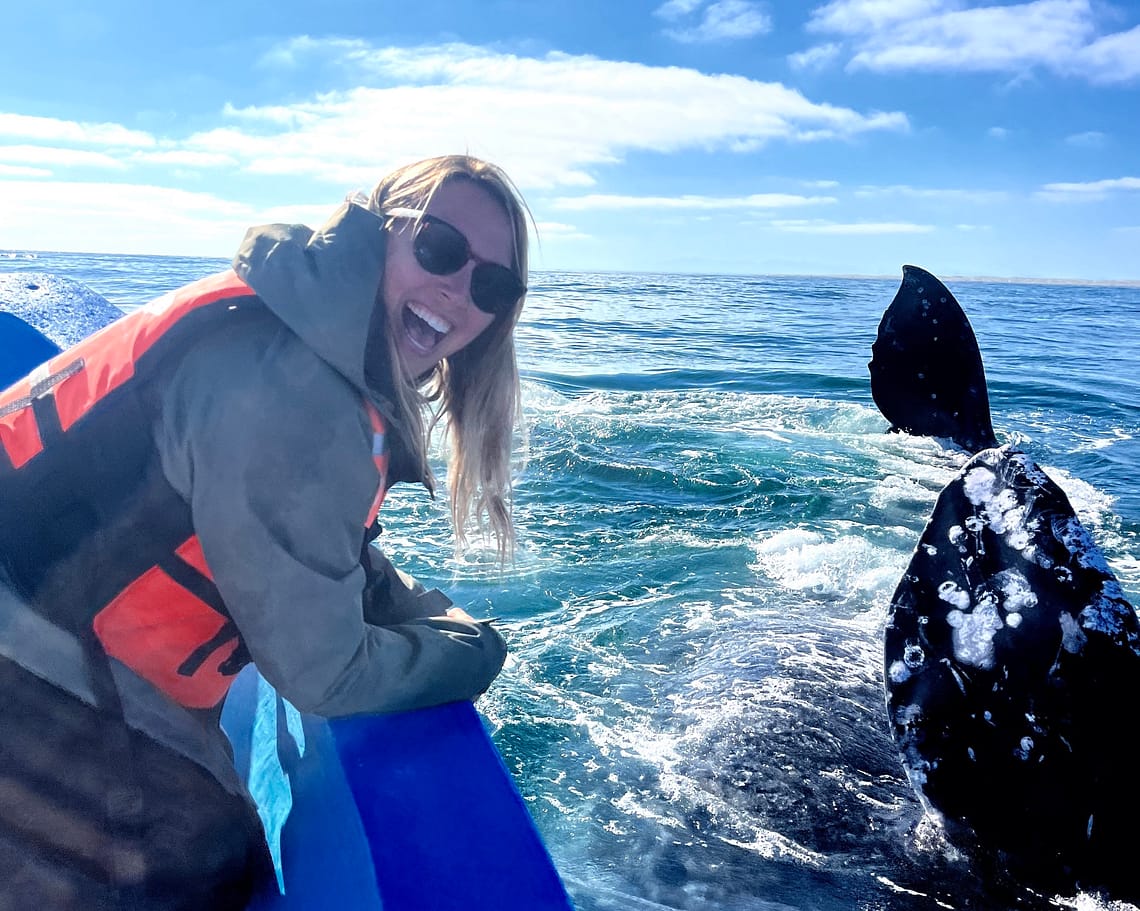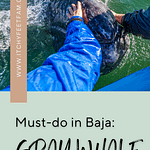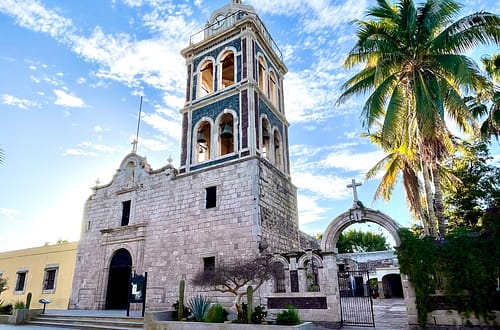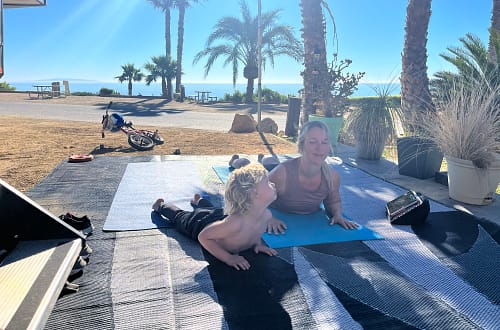One of the biggest checks I think we’ll ever check off our bucket list was accomplished this winter: visit the Gray Whales in Baja, and PET one! We’ve been on the road all the way from Vancouver Island, Canada, travelling south along the west coast, to eventually end up in southern Baja, and this stop was a must for me on this adventure…
About the Gray Whales in Baja
Gray Whales migrate around 16,000 km (10,000 miles) from the Arctic, alllllll the way down the west coast of Canada and the USA to the Baja California Peninsula! That’s more than any other mammal in the world!
They come here to their safe haven of these specific lagoons every year to mate, give birth and raise their babies until they’re strong enough to swim out in big water. This is the only place in the world these gentle giants feel safe enough to come to the boats for pets and kisses, and they are not shy at all! They love it!
These whales can get up to almost 50 feet long, and 90,000 pounds… which makes your boat (and you) feel reeeeeally small. There’s some Gray Whales they think that have lived over 70 years!

Mating
The Gray Whales choose to come to Baja to mate and have their babies in warmer water because it helps the newborns conserve body heat because they don’t have much body fat at birth.
Here’s some interesting facts we learned about the mating & calving process:
- two or more males hold up the female, while she mates with another, so she doesn’t sink
- the gestation period is about 13 months
- females give birth every 1-3 years, to one baby at a time
- there was only one ever case of conjoined babies (deceased) found in a Baja lagoon in 2014
- the baby is born tail-end first, and is about 15 ft in length, and 2,000 lbs
- babies drink up to 80 lbs of their mother’s 53% fat milk a day, for about 7 months
Our Tour to Visit the Gray Whales in Baja
Mario’s Restaurant & Tours
The easiest way to do it, is the “one stop shop” at Mario’s Restaurant & Tours, just north of Guerrero Negro, especially if you’re in your RV. We arrived in the afternoon, after a long drive from San Felipe. We checked into their RV park, which is right behind the restaurant. It has full hookups, and plenty of sites on a first-come, first-serve basis, at 350 pesos per night. Our little guy loved how they had giant scallop shells all over the roads and sites.


Once we were settled and relaxed, we went for a delicious seafood dinner of shrimps, scallops, lobster and fish. The restaurant itself is so interesting: it’s built almost entirely out of cacti, has really pretty decor, and super friendly staff. We took time to check out all the sea creatures with infographics and books on display to learn about ocean life. Anything to distract kids while waiting for a meal is always appreciated!

On our way out we popped into the office and were able to book a tour for the following morning, which leaves at 8am, right from the restaurant (so if you’re not camping, just pop into the restaurant/office to book). We paid 900 pesos per adult, and didn’t have to pay for our little guy, who was 3.
Tour Day
We met a half hour before our tour departed to have a little presentation, which was impressively informative. They taught us about the Gray Whales, the migration, the mating and birthing, Ojo de Liebre, the lagoon itself, and it’s history. We got to hold a whale baleen, and see models they had on display. There was time to ask any questions, and explore other creatures, posters, and books they had in the presentation room. We also learned about the salt-making process and how it is made in the lagoon and the surrounding salt flats.


We rode their small bus for about a 25 min to get to Ojo de Liebre, where we boarded the panga, the small boat we’d spend the next 2-3 hours on, exploring the lagoon. It was about a 10-15 minute ride out to deeper waters of the lagoon where it didn’t take long to see a whale breech and a big spout and everyone’s excitement began. Our driver stopped the boat, and almost immediately, the massive, barnacle-covered whales (three of them) came right up to the side of our boat.

I was already so surprised to see how quickly they came to us, and how soon they’d approached… I was not prepared for the amount of time we’d get to interact with these magical creatures. We spent over two hours just watching them swim under us, around us, popping their heads up for pets and kisses. We got a little wet from their blow holes spouting when they’d come up for air, not something I’d ever thought I’d experience, and would never complain about! Mario’s also had a packed lunch provided for us, which was a sandwich, some fruit and bottled water, which was a nice touch after being out there for so long.

What is the best time to see the Gray Whales in Baja? Peak season is January to March, but you can check out Mario’s Tours Instagram, and they post regularly once the whales arrive.
On the way back we were lucky enough to encounter a pod of dolphins, which playfully leapt around the bow of the boat while we cruised back into the shallow parts of the lagoon. We also got to see some Sea Lions basking in the sun around one of the salt barges, with a full load of 10,000 tons of salt!



Guerrero Negro Saltworks
The saltworks of Guerrero Negro, Exportadora de Sal S.A., was started in the 1950’s and located here for convenience, in the large flat areas around this lagoon, which has very high salinity. The salt here is not mined, but extracted from the lagoon’s water. The salt fields cover 33,000 hectares of land and ponds. Seawater is pumped into the fields and after more than a year, it evaporates to a point where the water becomes saturated with salt and crystallizes. The water is then pumped out and graders collect the salt and it’s eventually loaded onto barges and shipped out. They’re producing around 9 million tons a year! This place is actually the largest salt-making facility in the world!


It was an added bonus to get to learn about this salt-making process, after an already STELLAR morning. You have to drive through the saltworks to get to the boats that take you out into the lagoon, so it was great to learn what we were seeing from the bus, while passing through. We got to get out and explore a little… Rocky got to climb a giant salt pile and bring a crystallized piece home, which he was pretty pumped about.
We’d highly recommend this tour to visit the Gray Whales while travelling through Baja, Mexico! Another option is doing it in Laguna San Ignacio with either Pure Baja Travel or Antonio’s Tours (there are others, I’ve just heard good things about these two). The only thing: if you go this route, it’s a bit of a further drive into this lagoon from where you stay, and it just wasn’t as convenient for us staying in an RV.
Interested in other amazing things to do while visiting Baja? Check out this post on visiting Baja’s most famous beach:
…or this post on our favourite Baja community:
Thanks for reading. Stay itchy…







